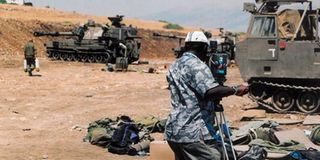Reporting at the frontline

Ibrahim Mugwanya films away during the 2006 Lebanon War in Israel. Courtesy Photo
What you need to know:
Battlefront. In 2006, Israel fought a 33-day war with one of her enemies in the region, the Lebanon-based Hezbollah. Ugandan Television (now Uganda Broadcasting Corporation) cameraman Ibrahim Mugwanya was working for Canadian Television CTV Africa bureau based in Kampala. In Witness this week, he narrates to Henry Lubega his experience at the front line with the Israel Defence Forces.
It was a short notice from the head office in Toronto requiring us to go and beef up the team in Israel. We went through Nairobi [Kenya], where I was to get a visa to Israel. I stayed behind waiting for the visa, while my Canadian colleague, Murray Oliver, went ahead of me. In Amsterdam [Netherlands], I was subjected to another interrogation before I boarded the flight to Ben Gurion International Airport in Israel. At the airport, I was subjected to another 45 minutes of interrogation by two young officers before I could be cleared to enter the country, despite having the visa and permit allowing me to work in the country as a journalist.
Having been cleared to enter, I headed for our bureau in Jerusalem at Jaffar Street, where I met Oliver. That afternoon, we set off from Jerusalem to Haifa ,which was the epic centre of action. On the way, despite the preparation and the training to work under harsh conditions, I kept wondering whether I would not return home in a coffin. In Haifa, we camped less than 200m away from the front line.
Katusha missiles were being fired from the Lebanon side to our (the Israeli) side at any time. On the second day, while chatting with Israel Defence Forces (IDF) soldiers, the missile landed not far from where we were standing, killing a number of them. This changed everything for us as journalists.
Whenever Hezbollah fighters fired a missile, the IDF missile detectors would trigger a siren to warn the public and the soldiers alike. The soldiers had their Armoured Personnel Carrier (APC) or Tanks to run to for cover, while the local communities in their Kibbutz (community residencies) had bunkers to run to in case of attacks. Our only place of cover was our vehicle, a Land Rover, which was not even armour plated.

Mugwanya during the interview on Wednesday. Photos by Rachel Mabala
For the entire month in Haifa, the maximum hours of sleep we had were only two hours because of the time difference between Israel and Canada, which was our broadcasting audience. Most of the fighting took place at night, though there were incidences when missiles would be fired into Israel and the IDF was forced to fire back even during day. But the day time fighting was not as fierce and prolonged as the night time.
Day time was spent looking for causalities in areas that have been hit. We mostly met them in hospitals. We also attended daily press briefings from the IDF, giving updates on the war.
At the start of the war, we almost had no limitations on which parts of the war front we were not allowed to film from. Right from the columns of military vehicles and soldiers entering Lebanon to fight the Hezbollah, up to the time the IDF ambulances started bringing back casualties and dead bodies, we filmed. As the war progressed, our filming was.
From the IDF frontline, one could easily see the other side of the Hezbollah fighters, who, according to me, had a field day because the IDF was using drones to determine which areas s to bomb, while their opponents were firing randomly. Every time the siren went off and we ran to our Land Rover, we prayed the missile lands far from our only place of sanctuary, otherwise we would get killed. After one month of living under the threat of being blown into pieces by a Katusha, I was more than delighted when I was told it was time to come back home.”
About the war
The 2006 Lebanon War, also called the 2006 Israel–Hezbollah War and known in Lebanon as the July War and in Israel as the Second Lebanon War, was a 33-day military conflict in Lebanon, northern Israel and the Golan Heights. The principal parties were Hezbollah Paramilitary Forces and the Israeli military. The conflict started on July 12 2006, and continued until a United Nations-brokered ceasefire went into effect in the morning of August 14 2006, though it formally ended on September 8 2006, after Israel lifted its naval blockade of Lebanon.\
The conflict is believed to have killed between 1,191 and 1,300 Lebanese people, and 165 Israelis. It severely damaged Lebanese civil infrastructure, and displaced approximately one million Lebaneseand 300,000–500,000 Israelis.
Additional source: wikipedia.org



